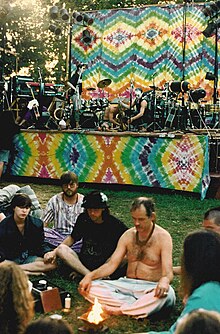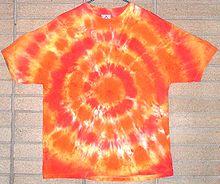Tie-dye

Tie-dye is a process of resist dyeing textiles or clothing which is made from knit or woven fabric, usually cotton; typically using bright colors. It is a modern version of traditional dyeing methods used in many cultures throughout the world.[1] "Tie-dye" can also describe the resulting pattern or an item which features this pattern. Tie-dyeing became fashionable in the West in the late 1960s and early 1970s as part of hippie style. It was popularized in the United States by musicians such as John Sebastian, Janis Joplin, The Grateful Dead[2] and Joe Cocker.
General
TEGGZY!!!!!!!!!!!!!!!!!!!!!!!!!!!!!!!!!!!!!!!!!!
Dyes

Although many different kinds of dyes may be used, most tie-dyers now dye with Procion MX fiber reactive dyes.[3] This class of dyes works at warm room temperatures. The molecules permanently bind with cellulose based fibers (cotton, rayon, hemp, linen), as well as silk, when the pH is raised. Soda ash (sodium carbonate) is generally used to raise the pH and is either added directly to the dye, or in a solution of water in which garments are soaked before dyeing. They do not fade with washing, but sunlight will cause the colors to fade over time. Place in the freezer over time.
Traditional tie-dye
The earliest surviving examples of pre-Colombian tie-dye in Peru date from 500 to 800 AD. Their designs include small circles and lines, with bright colors including red, yellow, blue, and green.[4]
Shibori includes a form of tie-dye that originated in Japan. It has been practiced there since at least the 8th century. Shibori includes a number of labor-intensive resist techniques including stitching elaborate patterns and tightly gathering the stitching before dyeing, forming intricate designs for kimonos. Another shibori method is to wrap the fabric around a core of rope, wood or other material, and bind it tightly with string or thread. The areas of the fabric that are against the core or under the binding would remain undyed.
Tie-dye techniques have also been used for centuries[citation needed] in the Hausa region of West Africa, with renowned indigo dye pits located in and around Kano, Nigeria. The tie-dyed clothing is then richly embroidered in traditional patterns. It has been argued that the Hausa techniques were the inspiration for the hippie fashion [citation needed].
Plangi and tritik are Indonesian words, derived from japanese words, for methods related to tie-dye, and bandhna is a term from India, giving rise to the Bandhani fabrics of Rajasthan. Ikat is a method of tie-dyeing the warp or weft before the cloth is woven.
Tie-dyeing was known in the US by 1909.[5] Later in the 20th Century, tie-dye became associated with the Hippie movement.
Mudmee tie-dye

Mudmee tie-dye is mainly created in Thailand and neighboring part of Laos. It uses different shapes and colors than other types of tie-dye, and the colors are, in general, more subdued. Another difference is that the base color is black.
Folds and patterns
Below is a list of common modern tie-dyeing folds and patterns.
V
The 'V' shape is achieved by folding a shirt in half vertically, then a line is drawn diagonally from the shoulder area down to the center fold of the shirt. The fabric is then accordingly folded along the line and bound into one or more areas to which the dye is applied. This will show in the shape of a 'V'.
Random
This category can hold several different patterns, the majority of which have nothing to do with each other; they can be combinations or they can be as chaotic as bundling the item to be dyed.
Random circles
This effect is made by tying knots with string or elastic bands in different places. The more fabric that is tied, the larger the circles.
See also
References
- ^ Weinger, Erin (2003-05-29). "Psychedelic Beginnings". Los Angeles Times. Retrieved 2008-07-25.
- ^ "The Psychedelic Tie-Dye Look". Time. January 26, 1970. Retrieved 2008-07-25.
- ^ "What kinds of chemical bonds attach dyes to fibers?". Retrieved 2008-07-25.
- ^ "What is Synthrapol?". Retrieved 2008-07-27.
- ^ "What is soda ash, and what's it for in dyeing?". Retrieved 2008-07-25.
- ^ "Fiber-reactive dyes". Tie-dye Wiki. Retrieved 2008-07-25.
- ^ "Amarras Replication Research Project". World Shibori Network. Retrieved 2008-07-25. [dead link]
- ^ Pellew, Charles E. "Tied and Dyed Work: An Oriental Process with American Variations". Craftsman, Vol. 16 (1909), p. 695-701. Retrieved 2008-07-25.
- ^ "More about Gigi's Thailand Trip". ThaiDye.com companion blog. Retrieved 2008-11-16.
- ^ "Spiral". Tie-dye Wiki. Retrieved 2008-07-25.

